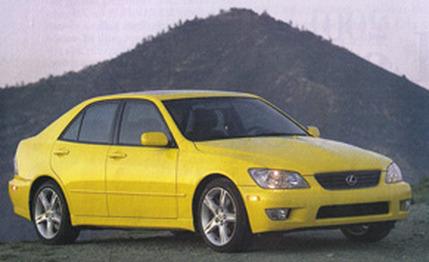 First Drive Review
First Drive Review
In a way, the car biz is a lot like theater. When you have the best play in town, you will inevitably inspire others to mimic your production, and many of these imitations will seem strangely familiar in plot and dialogue. Consider, for example, this car, a new addition to the Lexus lineup that is smaller than the ES300. Its tidy dimensions and short front overhang say sports sedan, just like the BMW 328i. Its in-line six sits up front and drives the rear wheels, just like the BMW 328i. Its all-disc, four-channel anti-lock brakes and meaty 17-inch tires suggest that it will thrive on a diet of hard stops and high lateral g, just like the BMW 328i.
The parallels are numerous. And in fact, Lexus freely acknowledges that the idea is to challenge BMW's supremacy in the small luxury sports-sedan sector, where the 3-series has ruled for so long. There was a time when such a notion -- a Japanese car presuming to compete with a master of the autobahns -- would have provoked snickers. But that time is long past, consigned to history by the original Lexus LS400 of 1990.
On the other hand, it's also fair to say that no Asian carmaker has really established a toehold on the small but prestigious patch of autoturf defined by the 3-series. At least until now. Zo. Ve take a closer look, ja? Your papers, bitte.
For openers, this IS300 is new to U.S. buyers, but it's been around for a while in other parts of the world. It debuted in Japan in 1998 as the Altezza, with a 2.0-liter straight-six and six-speed manual transmission, then showed up in Europe last year as the IS200. It's called the IS300 here because it's got mo' motor.
The IS300's chassis credentials certainly look good on paper. Almost identical in size to the 3-series Bimmer sedans -- although its 105.1-inch wheelbase is 2.2 inches shorter -- it sports double control arms at all four corners, brake discs the size of dinner plates (11.7-inch vented fronts, 12.1-inch solid rears) with electronic brake force distribution, and aggressive rubber: 215/45VR-17s on 7.0-inch-wide alloy wheels. There's also a 16-inch wheel-and-tire package with all-season radials, for those who set security as a priority over adventure. It's a no-cost option. If your instincts go the other way, Lexus offers a Torsen limited-slip differential, but that option does cost extra.
Power? Oh yeah. Plenty of that. The IS300 uses the same 2JZ-GE 3.0-liter DOHC 24-valve straight-six that propels the bigger Lexus GS300 sedan, an engine that traces its lineage to the old Toyota Supra. Like the GS300 version, it's enhanced by Toyota's VVT-i continuously variable valve-timing system, but its output is a smidge lower -- 215 horsepower and 218 pound-feet of torque vs. 220 horsepower and 220 pound-feet in the bigger car. The small disparity is attributable to the IS300's tighter engine bay, which cramps the exhaust system just a bit. On the other hand, the IS300 weighs in about 300 pounds south of its pudgier cousin, giving it a distinct edge in power to weight, not only within Casa Lexus but also vs. the 328i and Audi A4 2.8 as well.
There's a catch, at least for the IS300's first year in the U.S. market. Unlike its international counterparts, the IS300 won't offer a choice of transmissions. As in the GS300, the straight-six is paired with a five-speed quasi-manumatic whose steering-wheel pushbuttons allow the driver a degree of manual shifting, a la Porsche's Tiptronic S. And like the Tiptronic S, during particularly active driving episodes this arrangement results in situations where the driver is unable to punch the proper button at a critical moment. The system is also equipped with a logic chip that will occasionally make an unwanted upshift in manumatic mode, although keeping one's foot firmly to the floor prevents this. Lexus does plan to make a manual transmission available in about a year. It will have five forward speeds rather than six -- the six-speed used with the 2.0-liter engine won't handle the 3.0-liter's additional thrust -- and the reason for the delay is the government's certification process, which has only just begun. Curious, right? If you suspect that the home team back in Japan was reluctant to offer a manual gearbox, your suspicions are on the money. Arguing that a car designed to rival the 328i had to have a manual-transmission option, regardless of the take rate, the Lexus U.S. product planners finally won their point almost on the eve of the IS300's showroom debut.